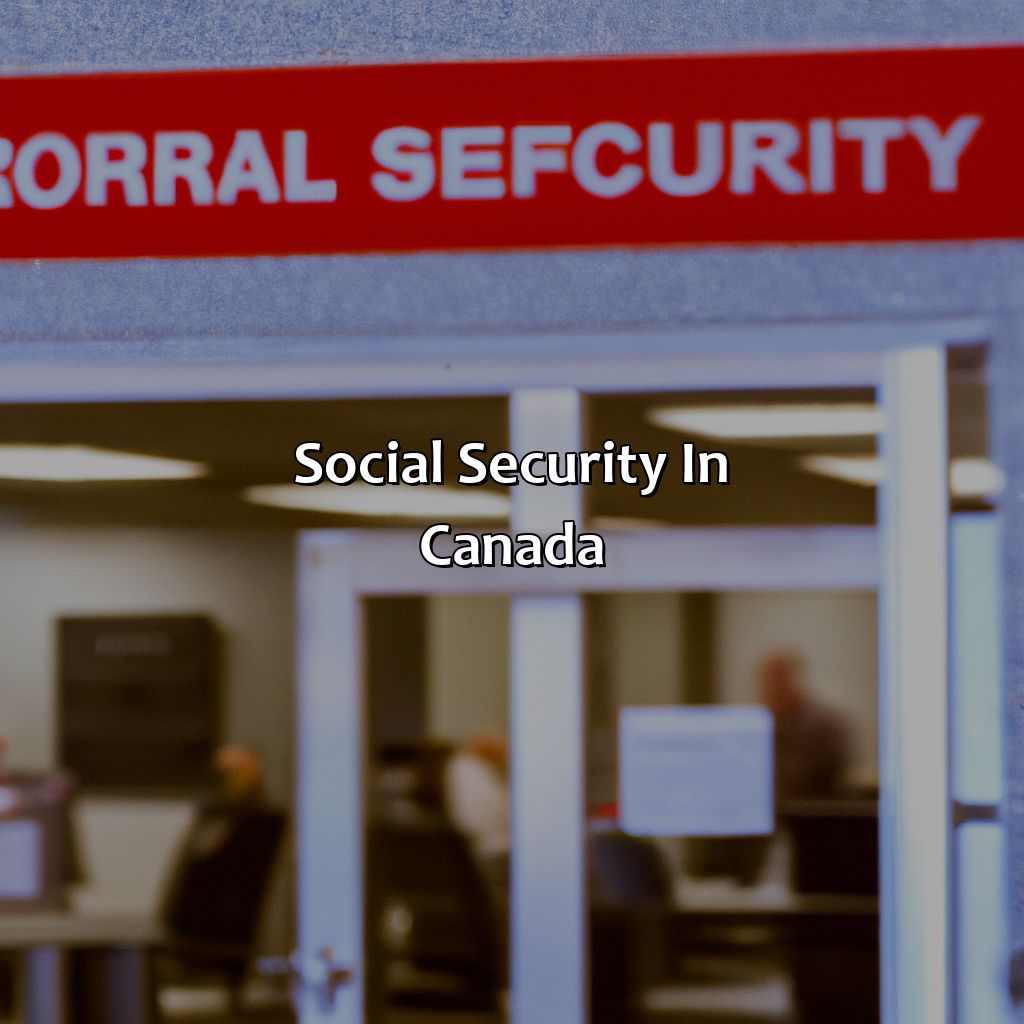What Is Social Security Called In Canada?
Key Takeaway:
- Social Security refers to a system of financial support provided to citizens who are retired, disabled, or in need of assistance.
- In Canada, Social Security is provided through various programs, including Old Age Security, Canada Pension Plan, Employment Insurance, and Canada Child Benefit.
- Eligibility for Social Security in Canada is determined based on several factors, including age, income, work history, and family situation. It is important to understand the specific requirements for each program to ensure eligibility and receive the maximum benefits.
Feeling overwhelmed by the complexities of social security in Canada? You can rest assured, as this article will provide clear and concise answers to your questions. Get ready to learn all about Canadian Social Security and how it works!
What is Social Security?
In Canada, Social Security is commonly known as the “Canada Pension Plan” (CPP), a national social insurance program that provides retirement, disability, survivor, and children’s benefits.
The program is funded by contributions from employers, employees, and self-employed individuals, as well as investment income generated by the CPP Investment Board. The amount of benefit received under the CPP varies depending on the contributor’s lifetime earnings, the age at which the benefit is received, and the length of time the individual has contributed to the plan.
It is important to note that the CPP operates alongside other government programs, such as Old Age Security and the Guaranteed Income Supplement, to provide a comprehensive retirement income system for Canadians.
Pro Tip: It is recommended to begin contributing to the CPP as early as possible to maximize retirement benefits.

Image credits: retiregenz.com by David Duncun
Social Security in Canada
Explore “Social Security in Canada” to find out more! Delve into two main parts – “Benefits of Social Security in Canada” and “Eligibility for Social Security in Canada.” Check out what benefits the system has to offer and what criteria you need to meet to receive them.

Image credits: retiregenz.com by Adam Woodhock
Benefits of Social Security in Canada
Canada’s Social Security system consists of various programs that cater to the needs of citizens and residents. These programs ensure financial protection in adverse situations, enhance the standard of living, and uplift the underprivileged sections of society.
- Income Support: The Canada Pension Plan (CPP) provides monthly retirement, disability, and survivor benefits based on contributions from individuals and employers. The Old Age Security (OAS) program offers pension payments to seniors aged 65 and above who meet certain legal requirements.
- Medical Coverage: The publicly funded healthcare system of Canada, known as Medicare, covers medically necessary hospital treatment, physician services, and prescription drugs for Canadian citizens or permanent residents.
- Social Assistance: Under the auspices of Employment Insurance (EI), eligible individuals can receive temporary financial assistance if they lose their job or fall ill. Moreover, there are provincial/territorial social assistance programs for people with disabilities or low income.
Apart from these programs’ tangible benefits, they also contribute towards social equality by ensuring accessibility to resources regardless of age, race, gender identity, or economic status.
It is advisable to stay informed about the eligibility criteria and application process for each benefit program to prevent any delays in receiving financial aid. Additionally, seeking professional guidance while navigating through the intricate policies can help secure maximum coverage possible from government schemes.
Eligibility for Social Security in Canada? Don’t worry, as long as you’re not a penguin, you should be good to go.
Eligibility for Social Security in Canada
Social Security benefits in Canada are available to those who meet the eligibility criteria set forth by the government. To qualify, individuals must have made contributions to the Canada Pension Plan (CPP) during their working years and must have reached a certain age. The amount of benefits received is proportional to the contributions made. Being eligible for Social Security in Canada also gives access to other government programs such as Old Age Security, Guaranteed Income Supplement, and the Canadian caregiver credit.
Moreover, eligibility for Social Security in Canada varies depending on an individual’s citizenship status and residency history. Non-Canadians can still qualify for CPP benefits if they have lived or worked in Canada long enough, or if they have contributed to a similar plan in a country that has a social security agreement with Canada. Similarly, Canadian citizens living abroad can still receive social security benefits if they meet certain requirements and continue to file tax returns.
It’s important to note that there may be additional factors that affect one’s eligibility for social security benefits beyond these basic criteria. For example, individuals with disabilities may qualify for additional support through the CPP disability benefits program or other government assistance programs.
I once met a retired couple who were able to enjoy their senior years comfortably thanks to their social security benefits from CPP and Old Age Security. Having contributed diligently throughout their careers, they were able to receive adequate financial support when it was needed most – in retirement.
Canada’s social security system has more types than a buffet – from pensions to disability benefits, it’s a smorgasbord of support.
Types of Social Security in Canada
Citizens of Canada need to understand the different types of social security. This section is titled “Types of Social Security in Canada“. It introduces you to four of these! Old Age Security (OAS), Canada Pension Plan (CPP), Employment Insurance (EI) and Canada Child Benefit (CCB). These are important programs that help out various parts of Canadian society.

Image credits: retiregenz.com by Adam Woodhock
Old Age Security (OAS)
Social Security for seniors in Canada refers to a government program aimed at providing financial support to eligible senior citizens. This program, commonly known as OAS, focuses on helping seniors who are 65 years or older to maintain their economic well-being. The OAS program provides monthly payments to eligible individuals who have lived in Canada for at least ten years since the age of eighteen. The amount of payment received depends on the number of years an individual has been a resident of Canada and earnings history.
In addition to providing basic income security to seniors, OAS offers various benefits such as GIS (Guaranteed Income Supplement), which is provided based on the income level of seniors. Other benefits include Allowance for the Survivor, designed for low-income widows or widowers aged 60-64 years, and Allowance for spouses, which is paid out to partners between the ages of 60-64 years.
Pro Tip: Seniors must apply for OAS six months before they turn 65 years old; otherwise, there might be delays in receiving payments.
Planning for retirement in Canada is like playing roulette, except the only thing you’re betting on is whether or not the CPP will still exist when you’re old and grey.
Canada Pension Plan (CPP)
The Canadian Pension System encompasses several retirement and disability benefits. One of them is a financial plan known as CPP, also called the Canada Pension Plan. It is a social program designed to provide Canadians with a stable income in their retirement years.
The CPP requires contributions from both employees and employers throughout the work period, which ensures that every contributor is eligible for pension payments when they retire or in case of disability. The amount paid out depends on the number of years contributed and the total amount paid into the fund.
Additionally, an individual can apply for early CPP benefits or delay withdrawal beyond retirement age to get higher income payments.
Notably, any missed contribution can be compensated by making payment adjustments under specific conditions through CRA (Canada Revenue Agency). These changes ensure that everyone receives accurate pensions depending on their contributions.
Overall, contributing to CPP guarantees financial security during retirement. To maximize your pension plans and receive better payouts, consider increasing your contributions from time to time to obtain optimal results.
Looks like Canada’s got their own version of The Office, except instead of a documentary crew, it’s the government keeping tabs on how much you get from Employment Insurance.
Employment Insurance (EI)
This social welfare program is available for Canadians who have lost their employment through no fault of their own. It offers temporary assistance to jobless citizens while they search for employment. The scheme is commonly known by the name “Employment Insurance (EI)”.
The program provides financial aid to individuals who are willing and able to work but are at present unemployed. EI also helps persons on maternity, parental, or illness leave. It safeguards employees’ earnings in the event of job loss and helps people maintain a minimum level of income while seeking new work opportunities. The benefits range based on the region’s unemployment rate, but it generally covers 55% of the claimant’s insurable earnings.
It may be enjoyable to learn that Employment Insurance began as Unemployment Insurance (UI) in Canada. In 1940, it was created under the auspices of the Unemployment Insurance Act and functioned until 1971 when it underwent a rebranding campaign and became called ‘Employment Insurance‘. Today, this social security program has been an essential support system for Canadian workers who have lost their jobs due to lack of work or unforeseen circumstances beyond their control.
Finally, a benefit that doesn’t involve having to teach your kid how to play hockey: the Canada Child Benefit.
Canada Child Benefit (CCB)
The financial aid provided by the Government of Canada to eligible families with children is a significant social assistance program. The ‘Canada Child Benefit‘ is a monthly non-taxable payment intended to support parents in raising their children.
- It offers support to families with children under 18 years old.
- The amount paid depends on factors such as incomes and family size, and it can be up to $6,833 annually per child.
- The payment can also include additional amounts for children with disabilities or low-income families.
- To apply for this benefit, an applicant needs to have filed income tax returns before receiving it.
Furthermore, the benefits of CCB are not merely monetary; it provides a practical solution for families striving to manage their day-to-day life expenses while nurturing their kids.
Interestingly, Canada’s social security policies were decolonized in the 1960s and 70s, which led them towards creating an efficient welfare system that caters to indigenous communities as well.
Five Facts About Social Security in Canada:
- ✅ Social security in Canada is commonly known as the Old Age Security (OAS) program. (Source: Government of Canada)
- ✅ It provides a basic monthly income to Canadian seniors aged 65 and over who meet the eligibility criteria. (Source: Service Canada)
- ✅ The amount of OAS pension payment received depends on how long the individual has lived in Canada since the age of 18. (Source: Canada.ca)
- ✅ The Canada Pension Plan (CPP) and Quebec Pension Plan (QPP) are separate programs that provide a monthly retirement income to eligible Canadians. (Source: Government of Canada)
- ✅ In addition to OAS and CPP/QPP, there are other federal and provincial/territorial social security programs available to Canadians, such as the Guaranteed Income Supplement (GIS) for low-income seniors. (Source: Canada.ca)
FAQs about What Is Social Security Called In Canada?
What is social security called in Canada?
Social security in Canada is commonly referred to as the Canada Pension Plan (CPP) and the Old Age Security (OAS) program.
What is the Canada Pension Plan (CPP)?
The Canada Pension Plan (CPP) is a social insurance program that provides retirement, survivor, and disability benefits to Canadians.
What is the Old Age Security (OAS) program?
The Old Age Security (OAS) program is a federal government program that provides a basic, non-contributory pension to eligible Canadians who are 65 years of age or older.
Who is eligible for the Canada Pension Plan (CPP)?
All workers in Canada, with the exception of those in Quebec, who are over the age of 18 and earn more than a minimum amount are required to contribute to the CPP. Individuals who have contributed to the plan may be eligible for benefits.
Who is eligible for the Old Age Security (OAS) program?
Canadian citizens and permanent residents who have resided in Canada for at least 10 years after the age of 18 may be eligible for the Old Age Security (OAS) program.
How do I apply for Canada Pension Plan (CPP) benefits or Old Age Security (OAS) program?
You can apply for CPP benefits or the Old Age Security (OAS) program online or by mail. Visit the Government of Canada’s website for more information and to apply.
